Top News
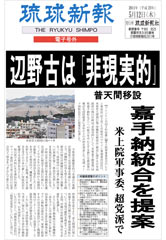
May 12, 2011 Ryukyu Shimpo
Carl Levin, Chairman of the Senate Armed Services Committee and John McCain, senior United States Senator, announced on May 11 that they consider the current plan put forward by both the U.S. and Japanese governments for the relocation of Futenma Air Station to be unrealistic. They asked the Department of Defense to consider an alternative plan, such as integrating the facilities now at Futenma Air Station into those at Kadena Air Base.
The U.S. Congress clarifying its opposition to the current plan may increase the likelihood of the Futenma relocation issue, which is still pending between U.S. and Japanese governments, to move even deeper into stalemate.
The announcement indicated that the current plan, which aims to relocate the facilities at the Futenma Air Station to Henoko, Nago City, is “totally unrealistic.” They further state that, “The significant estimated cost growth associated with some projects is simply unaffordable in today’s increasingly constrained fiscal environment.”
Governor of Okinawa Hirokazu Nakaima strongly questioned the feasibility of a plan that suggests the integration of Futenma Air Station into Kadena Air Base, saying, “Every time this has been suggested it has come to nothing. The local residents are dead against this idea and I cannot see how it would be possible to convince them to accept it.”
Nakaima emphasized the issue of Kadena Air Base noise, saying, “The noise level has continued to go up rather than down. Integrating Futenma Air Station into Kadena Air Base would double the noise level – who is going to accept that? Unless that is resolved, putting the facilities into Kadena is simply not viable. There are still several important questions that need to be resolved.”
However, Nakaima said, “While this statement does come from the Congress, it does indicate that the United States, which had previously been sticking to the current plan, is starting to show a little more flexibility on the Futenma issue.” Nakaima indicated that he would pay close attention to how the U.S. government and its military respond to the statement from Levin and McCain.
(English Translation by T&CT, Mark Ealey)
Go To Japanese 1
Go To Japanese 2
Go To Extra edition(PDF)
May 13, 2011 by Michiyo Yonamine of Ryukyu Shimpo
Three U.S. senators, including Carl Levin, the chairman of the Senate Armed Services Committee, have called for the Pentagon to abandon plans to relocate the U.S. Marine Corps Air Station Futenma facilities to the Henoko district of Nago, rejecting them as “unrealistic,” and “impractical.” These remarks reflect the great change in the circumstances in the United States in recent years, with growing public demand to cut defense spending because of huge fiscal deficits. Global U.S. strategy and deployment of its military needs to be reviewed now that progress seems to be made in the Middle East in the “War on Terror.”
In addition to the situation affecting the United States, Japan has been struck by a disaster of truly significant proportions and persistent objection to the relocation of the Futenma facilities to Henoko is unabated in Okinawa. With all this in mind, the three senators concluded that it is “unreasonable” to persist with the bilateral agreement between the United States and Japan.
They recommended to the Defense Department that the Futenma facilities and functions could be integrated into Kadena Air Base. This alternative to the current plan may reduce relocation costs and be feasible if Diet members from Okinawa lead the way in promoting it.
Since last year, there have been increasingly strong calls that plans should be reviewed as part of the government’s fiscal reconstruction of U.S. forces overseas, with the chairman of the House Financial Services Committee even going as far as arguing that the U.S. Marine Corps presence on Okinawa was unnecessary. Non-partisan members and some leading think tanks also advocate the withdrawal of U.S. troops from overseas bases. In a special feature article, TIME Magazine looked at the matter of whether or not the United States really needs more than 500 military bases at home and overseas, with experts on foreign affairs suggesting that after a deployment lasting 66 years, the U.S. Marines should now be withdrawn from Okinawa.
In this context, the recent killing of terrorist mastermind Osama bin Laden by U.S. special forces will be seen as an additional factor in heating up the controversy surrounding the withdrawal of the armed forces deployed overseas. The death the U.S. government’s most wanted man takes the “War on Terror,” that triggered the doubling of defense spending, to a new stage. Any termination of hostilities will lead to a decrease in military spending and the reduction of troop numbers. The statement by Levin and other senators is set against this changing situation in the political background in Washington, D.C.
In response, Japanese government officials act as though nothing has happened, saying that these are the remarks of some members of Congress, not by the U.S. government itself. Be that as it may, these remarks should not be taken lightly. Levin is the extremely capable chairman of the U.S. Senate Armed Services Committee that managed to reduce cost of the military relocation to Guam from Okinawa by 70%. McCain is a leading senior Republican and a former presidential candidate in 2008. Webb is the chairman of the Senate Committee on Foreign Relations East Asian and Pacific Affairs Subcommittee. These gentlemen have far more influence on their government than would be the case in Tokyo.
While some elements of the American news media do report the feelings of the Okinawan people about the Futenma relocation issue, there has been no news coverage whatsoever of the reaction triggered by the mention of the possible integration the facilities at Futenma into those at Kadena base. As has previously been the case, this may lead the American public to make mistaken assumptions. We therefore need to convey our strong opposition to any plan that involves the integration of the facilities and functions of Futenma into those of Kadena, and to clearly indicate why this option is “unrealistic.”
(English Translation by T&CT, Mark Ealey)
Go To Japanese

May 10, 2011 Ryukyu Shimpo
To raise money for the victims of the Great East Japan Earthquake, 15 year-old Bryce Tomo Wedig and his sister 14 year-old Hannah Marie Wedig, who live in Indiana, ran a stall at their Haru-matsuri (spring festival), held in Earlham College in Richmond, raising $1304.
Told by their grandmother that many of the earthquake victims have been taking refuge in Okinawa, the two children said, “We hope that those who have gone to Okinawa, particularly families with children, would accept donations.”
Soon after the earthquake, Bryce and Hannah said that they would like to do something for the earthquake victims.
They ran a stall in the Haru-matsuri (spring festival), which introduces Japanese culture, selling Japanese accessories and handmade sweets donated by The International Ladies Club and by Japanese people residing in Richmond.
Bryce and Hannah told customers that they would donate all the proceeds to the earthquake victims in Japan. Many people also donated cash.
Bryce and Hannah commented that, “We appreciate that so many Richmond people care about and want to support Japanese earthquake victims.”
After raising money for the victims at a garage sale in June, they are scheduled to visit Okinawa in the middle of that month.
Megumi Kinjo-Wedig, Bryce and Hannah’s mother, wants people to be informed, saying, “I think it will take quite some time for money raised by the government and large organizations to reach the victims. In the meantime, they can use this kind of money raised out in the community to help pay for things like their living expenses and school fees.”
Please contact Megumi by email for inquiries or further information: wedigk@Hughes.net
(English Translation by T&CT, Mark Ealey)
Go To Japanese
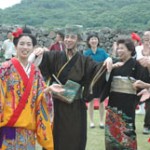
May 11, 2011 Ryukyu Shimpo
On April 30, dressed in the traditional costume of the Ryukyu Dynasty, Takahiro and Aiko Akiba, both of Tokyo, held their marriage ceremony at the World Heritage site Nakijin Castle. The newly-weds exchanged wedding vows in front of family members and tourists in what was the eighth such ceremony to be held at Nakijin Castle.
The bride and groom and the rest of the wedding group walked up the stars to the top of the main area of the castle. After 80 year-old Yoshiko Nakaoji, who is the noro or hereditary sacred woman of the castle, prayed for the couple’s future, they and heir fathers signed the marriage certificate. The Amesoko youth group then provided a special performance of eisa, a dance performed during the Obon season in honor of ancestors. In the closing ceremony, the participants danced the kachashi dance and celebrated the future of the new couple.
Aiko has been fond of the Nakijin Castle site ever since she came there to shoot a movie.
“I feel very emotional about having been able to hold our wedding here. I’m also really happy that everyone enjoyed it being held in traditional Okinawan costume,” she said.
“This is the first time for me to be the focus of attention of so many people,” her husband said with a shy smile.
(English Translation by T&CT, Mark Ealey)
Go To Japanese

May 9, 2011 Ryukyu Shimpo
The 95th All Okinawa Togyu (Bullfighting) Spring Tournament, sponsored jointly by the Okinawa Prefectural Bullfighting Federation and The Ryukyu Shimpo. Co., was held on May 8 at the Ishikawa Multipurpose Dome in Uruma City.Twenty-six bulls gave their all in front of 4000 fans who came to enjoy the action.
The open-class champion, Arakaze-go, defeated the challenger Furugen Motors in a bout that lasted 15 minutes and 27 seconds, thereby keeping the champion’s flag in his first title defense. In the middle-weight class, current champion Isshinriki showed his power against Higashiyamadairiki, winning in just 26 seconds. Seiryugo won the new champion’s title in the light-weight class, downing Toushou☆meka to win a fight that lasted 18 minutes and 25 seconds.
The tournament was held to raise money for the victims of the Great East Japan Earthquake. Okinawan bullfighting differs from that of Spain in that togyu pits bull against bull, with men only involved as handlers.
(English Translation by T&CT, Mark Ealey)
Go To Video
Go To Japanese

May 12, 2011 by Hideyoshi Tamahose, a correspondent of the Ryukyu Shimpo
The launching ceremony, or shinaurushi in the Okinawan dialect, of a traditional Okinawan fishing boat known as a sabani, was held at the Itoman Northern Fishing Port in Itoman Town on April 29. The sabani was in very poor condition with cracks and holes in its wooden hull when the Itoman Uminchu workshop took possession of it from a souvenir shop. Driven by a desire to preserve the cultural heritage that the boat represented and to pass it on to the next generation, boat-builder 61 year-old Kiyoshi Oshiro and his friends, also members of the workshop, took two and a half months to completely repair it to a state in which it looks as though it is brand new.
“It looked really battered, but by using a plane to make the wooden hull smooth we managed to bring the boat back to life. We are thrilled that it went well in the water,” said Oshiro.
Ken Uehara, 67 year-old representative of the workshop, said, “I never thought that we would get it to look this good. Oshiro-san’s involvement was crucial in our success. When we took it out on the water it was really stable and it will be great for people to experience what going out on the sea in a sabani is like.”
In the shinaurushi ceremony attended by some fifty people, Uehara prayed for the safety of the new sabani. After purifying it with sacred sake, the boat was put out on the water so they could check how it handled.
“There was not as much shaking as we thought there would be. It moved smoothly and was comfortable in the nice breeze,” said 34-year-old Noriko Fukushima said with a smile.
(English Translation by T&CT, Mark Ealey)
Go To Japanese
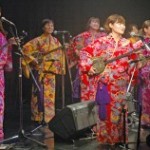
May 7, 2011 by Kenta Masuda of the Ryukyu Shimpo
Popular bus guides made their stage debut.
Six bus guides whose day-time job is guiding tourists around Okinawa on sightseeing buses formed a group called Utabus (singing bus) in which they made their stage debut in the live music house MOD’S.
Although the guides were already popular among tourists because of their performances in hotels for school trips, this was their first official performance in a live music house.
Naha Bus Co. Ltd., to which the guides belong, sees them as “singing and dancing bus guides” and intends to increase their number to 30. Naha Bus hopes to further add life to Okinawan tourism by promoting planned travel mixed with stage performances and solo concerts.
Explaining the background to the formation of the group, Ayako Yamashiro, one of the singers in Utabus who debuted said, “Some of us bus guides who like playing the sanshin, a traditional Okinawan string instrument, happened to practice together, and some tourists asked us to play more.” She continued, “We would like to make the group something unique to Naha Bus.”
The group was formed last June, with the bus guides training with a professional voice coach and a teacher of sanshin.
Singer-songwriter Yukihiro, who named the group Utabus, said, “The tourists go away with a lasting impression when they see the bus guides really enjoying singing songs for them.”
Up on stage, while showing pictures of sightseeing spots on a large screen, uniformed bus guides sing their way through a commentary.
In the second half of the performance, having changed into traditional Okinawan costume, the six bus guides sang a variety of songs such as Amazing Grace, Asatoya Yunta and Ojii Jiman No Orion Beer.
Itsuo Oshiro, the Head of Tourism Department of Naha Bus, said, “This is the first time in Japan that bus guides have made a stage debut. They guide tourists during the day, then they entertain people at night. We want to continue trying to think up projects that will help make people want to come back to Okinawa.”
(English Translation by T&CT, Mark Ealey)
Go To Japanese
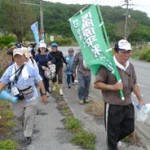
May 10, 2011 Ryukyu Shimpo
“Peace-Walk to learn from the Battle of Okinawa” was held on May 1, starting from the Haebaru Imperial Japanese Army Hospital Cave, Haebaru Town, and finishing at the Itokazu Cave Abuchira-gama in Nanjo City. This was the second time that such a Walk has been held this year. Some sixty participants, aged from elementary school children to people in their 70s, took as long as three hours to walk the distance of about nine kilometers in light rain. On the Walk they listened to stories of survivors and to explanations from volunteer guides at the caves, experiencing for themselves an aspect of the war and appreciating the preciousness of peace.
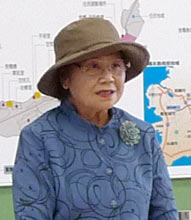
Yoshiko Shimabukuro
Held since 2010, the first Peace-Walk of this year was held on April 1, the day that U.S. forces landed on the main island of Okinawa. The participants started from Sunabe in Chatan Town and walked to Nodake in Ginowan City, where the holding camps were located.
The latest Peace-Walk was timed to coincide with the date of some of the Himeyuri Corps moving to the southern part of the island. Before the participants went into the Abuchira-gama Cave, they listened to the experiences of a survivor of the Himeyuri Corps, 83 year-old Yoshi Shimabukuro, who now lives at Naha City. Shimabukuro tended to wounded soldiers as the fighting in the Battle of Okinawa reached its peak. After departing from Haebaru on April 28, 1945, she reached Abuchira-gama in the morning of May 1.
Touching upon her terrible experiences nursing the soldiers in the shelter, she recalled: “At the beginning, we were scared of the maggots that came out of the men’s wounds, but there were so many soldiers to care for that we just got used to it. Many died still believing that reinforcements were on their way. I can never think that war is permissible,” Shimabukuro said.
Forty-nine year-old Haebaru resident Masatomo Shiroma and his 11 year-old son Tasuku said, “We were surprised at how small the hospital cave is inside. The distance to walk was more difficult than we had expected, so it must have been really tough back then.
” The Executive Committee will hold the Peace-Walk on around June 23, Battle of Okinawa Memorial Service Day, and around September 7, which was when the surrender document was signed by representatives of the Imperial Japanese Army on the Ryukyu Islands, and the United States Forces.
(English Translation by T&CT, Mark Ealey)
Go To Japanese

May 9, 2011 Ryukyu Shimpo
Well-known ventriloquist Ikkokudo, whose real name is Ikkoku Tamaki, recently visited his old school, Chatan High School, in Chatan Town. In his speech to the students he advised that, “It is important for you to take small steps towards your goals in life.” The students were all impressed with his demonstration of his ventriloquist skills. He told them how he used to imitate the teachers at the school’s morning gathering to develop confidence towards achieving his dream of becoming a performer in future. He fondly recalled his days at high school.
First-year student Momona Tamaki said, “I don’t really have a clear idea of my dream for the future, but I want to do my best to achieve what I have in front of me now. ”
(English Translation by T&CT, Mark Ealey)
Go To Japanese
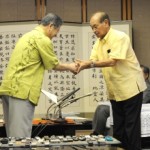
May 7, 2011 Ryukyu Shimpo
On May 7, Minister of Defense Minister Toshimi Kitazawa met with the Okinawan Prefectural Governor Hirokazu Nakaima at the Prefectural Government Offices. Kitazawa stated, “While we are mindful of your feelings and your political position as the Governor of Okinawa, we are must seek to fulfill the bilateral agreement between Japan and the United States that was concluded in May last year. The Japan-U.S. Security Treaty and Japan-U.S. alliance are important for security in the Asia Pacific, so I want to strive to achieve understanding of that point.” He emphasized that the Government has not changed its policy of staying in line with the bilateral agreement and relocating the facilities at Futenma to Henoko.
Kitazawa said measures to mitigate noise caused by caused the operation of U.S. military aircraft are being considered. “We would like to announce these measures at the Two-plus-Two meeting of the U.S.-Japan Security Consultative Committee or at the Summit of Japan and the United States,” he said.
Kitazawa visited what used to be the Awase United States Marine Corps Golf Course after the meeting with the Area Coordinator of U.S. Forces in Okinawa, at Camp Foster (Zukeran).
(English Translation by T&CT, Mark Ealey)
Go To Japanese
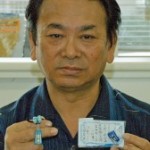
May 7, 2011 by Ryota Shimabukuro, Ryukyu Shimpo
Aiming to make people happy in their daily lives, Takeo Medoruma, founder of RYUKYUKOKU MATSURI DAIKO (Ryukyu Kingdom Festival Drums), an international dance and drum performance organization that specializes in an exciting blend of traditional and contemporary Okinawan and Japanese music, has created cards that introduce 100 Okinawan words representing good luck.
He has also created glass cell-phone charms and necklaces using a minsah pattern, a traditional Okinawan textile known for representing the desire for eternal love and happiness.
Medoruma intends to send the cards and charms to Ibaraki to coincide with the opening ceremony on May 28 of a RYUKYUKOKU MATSURI DAIKO group in that prefecture, which has been affected by the Great East Japan Earthquake.
The cards introduce words from the Okinawan dialect such as champloo (a mixture of various different things) and moai (the traditional Okinawan system of mutual assistance).
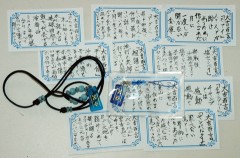
Cards with 100 words or phrases that were created by Medoruma, and glass cell-phone charms with the minsah pattern.
Medoruma came up with the idea of creating the cards and charms after witnessing the devastating earthquake in East Japan.
The Ibaraki chapter expects about 30 people to join.
Medoruma will send cards and charms to the Sendai chapter, which currently has 14 members. Sendai is among the earthquake-stricken areas.
He intends to send charms adorned with artwork depicting the fundu, a fixture that joins the boards on a sabani (a traditional Okinawan fishing boat), so as to represent the “bond” that exists between Okinawa and the earthquake stricken areas.
Medoruma said, “My desire to see the people affected by the earthquake return to their normal lives as soon as possible made me create these cards and charms.”
(English Translation by T&CT, Mark Ealey)
Go To Japanese












 Webcam(Kokusai Street)
Webcam(Kokusai Street)


